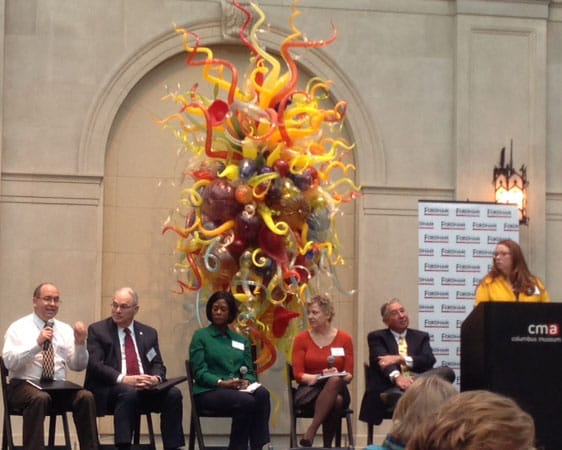 From left: Marty Bowe, Bill Hayes, Carol Lockhart, Ann Sheldon, Checker Finn and Jennifer Smith Richards
From left: Marty Bowe, Bill Hayes, Carol Lockhart, Ann Sheldon, Checker Finn and Jennifer Smith Richards
Why are so many gifted students in Ohio not receiving education services catered to their needs? How can we support them to reach their full potential? These were the questions asked at today’s Educating Our Brightest event, hosted by the Fordham Institute and the Ohio Association for Gifted Children.
Fordham's Checker Finn kicked off the event with a recap of the Institute’s studies of the impact of No Child Left Behind on gifted students (hint: it’s not good). He then presented findings from his recent book, Exam Schools: Inside America’s Most Selective Public High Schools (of which Ohio has four). He was quick to point out that these students don’t serve a different population of students than their peers, nor do their teachers necessarily have different or higher credentials.
After Checker’s presentation, a panel, moderated by the Columbus Dispatch’s Jennifer Smith Richards, talked about the state of gifted education in Ohio and how to improve it. Here’s a recap of their comments:
Ann Sheldon, Executive Director, Ohio Association for Gifted Children: Ann pointed out there has been a tremendous decline in gifted services in Ohio over the past decade. Currently just 18 percent of gifted students received specialized gifted services in our state. Ohio needs more gifted-specific schools as part of the solution.
Carol Lockhart, Principal, John Hay Early College High School: Carol says her school proves that gifted education can be done well with challenging populations—her student body is virtually 100 percent eligible for free and reduced-price lunch. And the school has incorporated blended learning as a key component of its model.
Bill Hayes, Ohio House of Representatives: He acknowledged that gifted students are underserved, but reiterated that he believes the governor’s budget proposal seeks to improve gifted ed in Ohio through increased funding and accountability. He agrees we need more gifted-specific schools in Ohio but also said it’s tough to get lawmakers interested in supporting issues that don’t impact their districts.
Marty Bowes, Superintendent, Perry Local Schools: Marty was honest that money is a factor: he has more gifted students than special ed students in his district, yet he gets $4 million in special ed funding and just $200,000 in gifted dollars. He says we need to energize our teaching force for gifted students and beyond—imagine the value of getting a 50th percentile student to the 75th? And what would happen if his valedictorian had a one-to-one gifted aide, the way that many special education students do? What could she achieve in that environment?
Checker closed the conversation with his advice about gifted education advocacy in Ohio (and nationally). Ohio is a paradox in that schools are required to identify gifted students but not to serve them—that should have the makings of a political revolution of sorts among parents. Instead, advocacy is old-fashioned and needs to catch up with more sophisticated political strategies.
Governor Kasich’s budget includes increased funding for gifted education and a bit more accountability for serving those students. But gifted advocates say the legislation can be improved—stay tuned to the Ohio Gadfly Daily for updates as the bill evolves.
